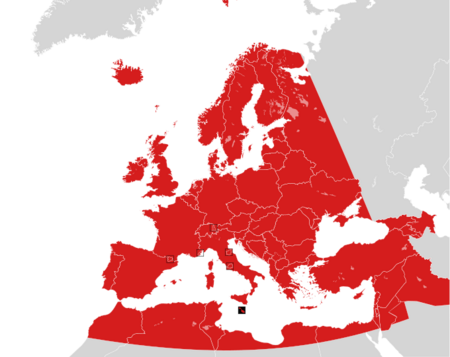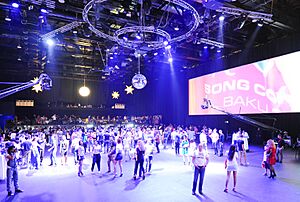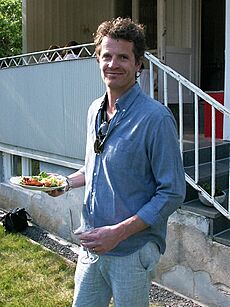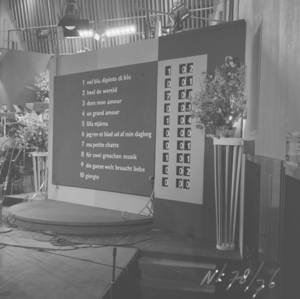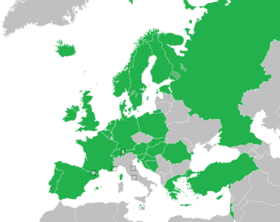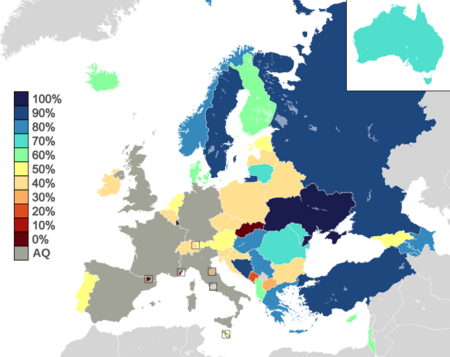Eurovision Song Contest facts for kids
Quick facts for kids Eurovision Song Contest |
|
|---|---|

Logo since 2015
|
|
| Genre | Music competition |
| Created by | European Broadcasting Union |
| Based on | Sanremo Music Festival |
| Presented by | Various presenters |
| Country of origin | Various participating countries |
| Original language(s) | Various; primarily English and French |
| No. of episodes |
|
| Production | |
| Production location(s) | Various host cities |
| Running time |
|
| Production company(s) | European Broadcasting Union Various national broadcasters |
| Release | |
| Original release | 24 May 1956 – present |
| Chronology | |
| Related shows |
|
The Eurovision Song Contest, often called Eurovision, is a big international music competition. The European Broadcasting Union (EBU) organizes it every year. Countries send an original song to be performed live on TV. Then, they vote for other countries' songs to pick a winner.
This contest started in 1956. It was inspired by the Sanremo Music Festival in Italy. Eurovision is the longest-running international music competition on television. It has happened every year since 1956, except for 2020 due to the COVID-19 pandemic. Broadcasters from 52 countries have taken part at least once.
Each country sends a song that is three minutes or less. A singer or group of up to six people performs it live. All performers must be 16 or older. Countries give points (1-8, 10, and 12) to their top ten favorite songs. These points come from music experts and the public. The song with the most points wins!
Besides the competition, there are special performances. These include opening acts, guest singers, and other famous people. Past guests include Madonna and Justin Timberlake. The show started as one evening event. But as more countries joined, it grew. Now, it has semi-finals before the big final.
The contest is usually held in the country that won the year before. This helps promote the host country and city for tourism. Thousands of fans and journalists attend each year. They cover rehearsals, press conferences, and other events. Eurovision is watched by hundreds of millions of people worldwide. Performing at Eurovision can help artists become famous. Many best-selling artists, like ABBA and Céline Dion, have competed.
Eurovision is very popular, but it also gets some criticism. Some people worry about countries voting for their friends. Others think the stage shows are too fancy. However, many love Eurovision for its fun style and diverse music. It has a huge fanbase and influences pop culture. Its popularity has led to other similar events.
Contents
How Eurovision Started
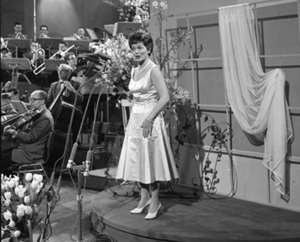
The European Broadcasting Union (EBU) was created in 1950. It brought together 23 broadcasting groups. The word "Eurovision" was first used in 1951 by a British journalist. He used it to describe a TV show being shared between countries.
In 1955, an EBU committee looked into new ideas for broadcasters to work together. They liked the idea of a European song competition. This idea came from an Italian TV manager. The EBU agreed to organize the contest in October 1955. They first called it the European Grand Prix. Switzerland offered to host the first event in Lugano in 1956. The Italian Sanremo Music Festival helped them plan the contest. Eurovision was a way to test live TV across countries. It also helped promote TV and new songs.
Seven countries took part in the first contest. Each country had two songs. This was the only time multiple songs per country were allowed. The winning song was "Refrain" from Switzerland. It was sung by Lys Assia. Voting was private at first. Only the winner was announced. Public voting results started in 1957. The tradition of the winning country hosting the next year's contest began in 1958.
Technology has changed the contest a lot.
- Color broadcasts started in 1968.
- Satellite broadcasts began in 1985.
- Online streaming started in 2000.
- Widescreen broadcasts began in 2005.
- High-definition (HD) started in 2007.
- Ultra-high-definition (UHD) was tested in 2022.
By the 1960s, about 16 to 18 countries competed each year. Countries outside Europe, like Israel and Australia, also started joining. After the Cold War, more countries from Central and Eastern Europe joined. This meant too many countries wanted to compete for one night.
Different solutions were tried. In 1993, a special pre-qualifying round was held for seven new countries. From 1994, a system was used where countries with low scores had to miss the next year. This helped manage the number of entries. In the 2000s, semi-finals were added. This allowed all interested countries to compete.
There have been 69 contests as of 2025. This makes Eurovision the longest-running annual international TV music competition. A record 43 countries participated in a single contest in 2008, 2011, and 2018.
The 2020 contest was canceled because of the COVID-19 pandemic. No competition could happen due to travel and gathering rules. Instead, a special show called Eurovision: Europe Shine a Light honored the songs and artists.
Contest Names
The contest has had different names in various languages. The first contest had official names in Italian, French, and English. Unofficial names like "Eurovision Schlagerfestival" (Swedish) were also used. The names Eurovision Song Contest and Concours Eurovision de la Chanson (French) became common. The contest was briefly called Eurosong in English in 1996.
Names were made standard in 2004. The official rules say that translations can be used. But the name Eurovision Song Contest is always preferred. Only four times has the official logo name not been in English or French. This happened when Italy and the Netherlands hosted.
How the Contest Works
Original songs from different countries are performed live. They are broadcast at the same time to all countries. Each country is represented by one TV broadcaster. This is usually their national public TV company. The show is put on by the host country's broadcaster. It takes place in a chosen city's auditorium.
Since 2008, each contest has three live TV shows over one week. Two semi-finals are on Tuesday and Thursday. The final is on Saturday. All countries compete in a semi-final. The only exceptions are the host country and the "Big Five." These are countries whose broadcasters pay the most to the contest. They are France, Germany, Italy, Spain, and the United Kingdom.
The other countries are split between the two semi-finals. The top 10 songs from each semi-final move on to the final. This means 26 songs compete in the final. Since 2004, Luxembourg and Ukraine are the only countries outside the "Big Five" to always reach the final when they compete.
Each country's broadcaster chooses its song. They might have a TV show where the public votes. Or a committee might pick the song internally. Sometimes, it's a mix of both. Sweden's "Melodifestivalen" is a very popular selection show. It started in 1959.
Each show usually starts with an opening act. This can be music or dance. It helps create a unique theme for that year. Since 2013, the final's opening includes a "Flag Parade." Artists walk onto the stage with their country's flag. This is like the Olympic Games opening.
One or more presenters welcome viewers. They give updates, interview artists, and guide the voting. They speak in English and French. After all songs are performed, viewers can vote for their favorites. They cannot vote for their own country. Voting is done by phone, SMS, or the official Eurovision app. The public vote counts for 50% of the final score. The other 50% comes from a jury of music experts.
During the voting time, there is an "interval act." This often features a famous person from the host country or an international star. The results are then announced. In the semi-finals, the 10 qualifying countries are announced in a random order. The full results are kept secret until after the final. In the final, a spokesperson from each country announces their jury's points. Then, the presenters announce the public vote totals. The winning artists and songwriters get a trophy. The winning song is performed again. The full results are put online after the final. The winning country's broadcaster usually hosts the next year's event.
Who Can Participate?
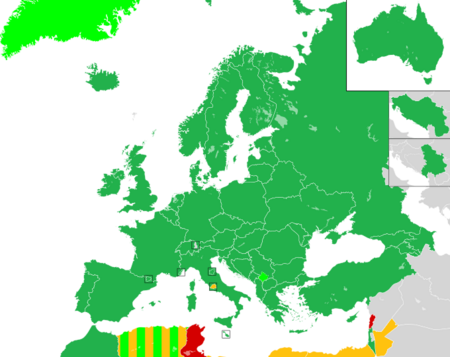
Members of the European Broadcasting Union (EBU) can participate. These are broadcasters in countries within the European Broadcasting Area (EBA). The EBA includes Europe, parts of Western Asia, and North Africa. So, countries like Israel, Cyprus, and Morocco have competed.
Australia was the first country outside the EBA to compete. This happened in 2015 for the 60th contest. Australia has participated every year since then.
EBU members must follow the contest rules. They also pay a fee to the EBU. This fee depends on the country's size and viewership. A maximum of 44 countries can take part in any contest.
Broadcasters from 52 countries have participated at least once. Here are some of the countries and their first year:
|
|
|
Hosting the Contest

A single hosting Multiple hostings
The country that wins Eurovision usually hosts the next year's event. This has been a tradition since 1958. Hosting the contest is a great chance to show off the country and city. It can boost tourism and the local economy.
Planning for the contest starts right after the previous one ends. The winning country's team gets information on how to host. Eurovision is not meant to make a profit. It's paid for by fees from participating broadcasters. The host city and broadcaster also contribute. Money also comes from sponsors, ticket sales, and merchandise.
The host broadcaster chooses a city. This is usually a capital city. The venue must hold at least 10,000 people. It also needs a press center for 1,500 journalists. It should be easy to reach from an international airport. There must be enough hotels for 2,000 guests. Different places have been used, from small theaters to large stadiums. The biggest venue was Parken Stadium in Copenhagen in 2001. It held almost 38,000 people. Millstreet, Ireland, was the smallest host town in 1993. It had only 1,500 people.
Unlike the Olympic Games, Eurovision doesn't usually build new venues. Most contests are held in existing places. But sometimes, venues are updated for the show. For example, the Baku Crystal Hall in Azerbaijan was built for the 2012 contest.
Eurovision Look and Theme
Before 2004, each contest had its own logo and look. The host broadcaster designed it. To make things consistent, the EBU created a general logo in 2004. This logo has a heart with the host country's flag inside. The original logo was designed by JM International. It was updated in 2014 for the 60th contest.
Each year, the host broadcaster creates a unique theme. This theme influences the stage design, opening acts, and "postcards." Postcards are short videos shown between songs. They started in 1970. They usually show off the host country and introduce the next artist.
A unique slogan was used for each contest from 2002 to 2023. Now, there is a permanent slogan: "United by Music." This slogan was first used for the 2023 contest.
Getting Ready for the Show
Work on the host venue starts about six weeks before the final. This allows time for building and technical rehearsals. Teams from each country arrive two to three weeks before the show. Each country has a "head of delegation." This person manages their team and talks to the EBU. Teams include performers, songwriters, and press people. Commentators also come to describe the show in their own language.
Each team has two private rehearsals. The first is 30 minutes, the second is 20 minutes. Semi-finalists rehearse first. The host country and "Big Five" rehearse later in the week. After rehearsals, teams meet with the show's producers. They review footage and ask for changes. "Meet and greet" sessions are held for fans and press.
Before each live show, there are three dress rehearsals. The whole show is run exactly as it will be on TV. The second dress rehearsal is called the "jury show." It's recorded as a backup. Juries use this performance to decide their votes.
A welcome party is usually held on the Sunday before the live shows. It includes a red carpet for all countries. This is often broadcast online. Delegates, press, and fans can go to the "EuroClub," a special nightclub. Some teams also host their own parties. The "Eurovision Village" is a free fan zone. It has live performances and big screens to watch the shows.
Rules of the Contest
The EBU organizes the contest with the host broadcaster. An "executive supervisor" from the EBU watches over the event. The "reference group" represents all participating broadcasters. They approve the rules. Martin Österdahl was the executive supervisor from May 2020 to June 2025.
The EBU writes detailed rules each year. These rules cover things like:
- What kind of songs can compete.
- How the contest is set up.
- How the winner is chosen.
Song Rules and Languages
All songs must be three minutes or less. This rule only applies to the live performance. Songs cannot be released commercially before September 1st of the previous year. All songs must have singing and lyrics. Songs with no singing or only instruments are not allowed. Songs can be in any language, real or made-up. Countries can choose any language for their song.
Language rules have changed over time. At first, there were no rules. But after Sweden's 1965 song was in English, a new rule came in 1966. Songs had to be in an official language of the country. This rule was removed in 1973. It was brought back for most countries in 1977. But it was removed again in 1999.
Songwriters can be from any country. They can also write multiple songs for different countries in one year. For example, Ralph Siegel wrote songs for both Germany and Luxembourg in the same year. He also wrote Germany's winning song in 1982.
Artist Rules and Performances
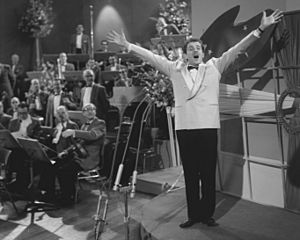
At the first contest, only solo singers could enter. Duos were allowed the next year. Groups were allowed in 1971. Now, a maximum of six people can be on stage. No live animals are allowed. Since 1990, all contestants must be 16 or older on the show day. Sandra Kim won for Belgium in 1986 when she was 13. She is the youngest winner ever.
Artists can be from any country. They can also represent a country different from their own. An artist cannot compete for more than one country in a year. Artists can compete again in future years. They can even try to win again, like Lys Assia and Lena did. Only two artists have won more than once: Johnny Logan (twice for Ireland) and Loreen (twice for Sweden).
From 1956 to 1998, a live orchestra played for all songs. Pre-recorded backing tracks were allowed in 1973. But any recorded instruments had to be "played" on stage. In 1997, all instrumental music could be pre-recorded. In 1999, the orchestra became optional. The host country that year chose not to have one. So, all acts used backing tracks for the first time.
The main singing must be live. Since 2021, backing vocals can be pre-recorded. This change was made to add flexibility and modernize the show.
Performance Order
Since 2013, the show's producers decide the order of performances. This helps make the show more interesting for TV viewers. It avoids having similar songs back-to-back. Before this, the order was chosen randomly.
A semi-final draw happens each year. Countries are put into groups based on their location and past voting. Then, they are randomly assigned to one of the two semi-finals. They are also assigned to perform in the first or second half of their semi-final. Once all songs are chosen, producers set the exact order. The "Big Five" and host country automatically qualify for the final. They are assigned to a semi-final for voting purposes.
Semi-final qualifiers draw a random spot for the final. They pick if they will perform in the first or second half. The automatic finalists also draw their half. The host country's exact spot is chosen in a separate draw. The final running order is decided after the second semi-final. Producers consider the songs' style, stage needs, and other production details.
How Voting Works

The results are decided by a point system. The newest version started in 2023. Each country gives 1-8, 10, and 12 points to their ten favorite songs. The most liked song gets 12 points.
In the semi-finals, each country gives one set of points. These points mainly come from the public vote (phone, SMS, or app). In the final, each country gives two sets of points. One set is from the public. The other is from a jury of five music experts.
Since 2023, viewers in countries not competing can also vote. Their votes are combined and count as one "extra country" in the public vote. This system is based on the "12 points" system from 1975. Juries and the public cannot vote for their own country. This rule started in 1957.
In the past, only juries decided the points. As technology improved, televoting (public voting) was tested in 1997. From 1998, televoting was used in almost all countries. It became mandatory in 2004. A jury was brought back for the final in 2009. Their votes were combined with the public vote. This mixed system was used in semi-finals from 2010. In 2023, full public voting returned for the semi-finals. The mixed jury and public vote is still used in the final.
If two or more countries have the same points, a tie-break rule is used. The country with more points from the public vote wins the tie.
Announcing the Votes
Since 1957, each country's votes are announced during a special part of the show. A spokesperson from each country announces their results. These spokespersons are often famous in their home country. In the past, they announced votes by phone. In 1994, satellite links were used. This allowed viewers to see the spokespersons.
Both a national jury and a public televote decide the scores. Each country's jury points are added to the scoreboard. The scoreboard used to be updated by hand. In 1988, a computer graphics scoreboard was introduced. The points from 1-8 and 10 appear on screen automatically. Then, the spokesperson announces which country gets the 12 points.
After all jury points are announced, the presenters reveal the public vote totals. These are announced as one total for each country. Since 2019, public points are revealed from lowest to highest. The country with the fewest jury points gets its public points first. Full results are published online after the final. This includes detailed jury and public votes. Each country's public vote points are usually shown on their own TV broadcast after the winner is announced.
Broadcasting the Show
Participating broadcasters must show the semi-final they are in, and the final, live and in full. This includes all songs, a quick recap of performances, and the voting results. Since 1999, broadcasters can show ads during short breaks. If a broadcaster doesn't air the show as expected, they might face penalties from the EBU. Many broadcasters who don't compete still show the contest in their countries.
When broadcasters join or leave the Eurovision TV feed, a special logo appears. The music played with it is from "Te Deum" by Marc-Antoine Charpentier. The EBU now has recordings of almost all contests. Only a short clip of the 1956 contest and no full recording of the 1964 contest exist. Audio recordings of both do exist. Until 2004, the host broadcaster owned the copyright for their contest. Now, the EBU owns the copyright for all new editions.
How the Contest Grew
The contest started with seven countries in 1956. The number of countries grew steadily. By 1965, 18 countries participated. By 1990, 22 countries competed every year.
Big changes in Europe in the late 1980s and early 1990s affected the contest. Countries like Yugoslavia broke up. New countries joined the EBU. This meant many more broadcasters wanted to participate.
Pre-selections and Relegation
In 1993, 29 countries wanted to join. This was too many for one show. So, a pre-selection round was introduced. Seven new countries from Central and Eastern Europe competed in a special show. Only three of them, Bosnia and Herzegovina, Croatia, and Slovenia, went to the main contest.
A new "relegation system" started in 1994. Countries with the lowest scores had to miss the next year's contest. They were replaced by countries that hadn't competed recently. This system changed a few times over the years. For example, in 1996, an audio-only qualification round was held. This was to help countries like Germany, a big financial supporter. Germany still missed out that year. As of 2024, this is the only contest Germany has not been in.
The "Big Five" Countries
In 1999, a special rule was made for France, Germany, Spain, and the United Kingdom. They were allowed to compete automatically every year. These countries pay the most to the EBU. They became known as the "Big Four." In 2011, Italy rejoined, making them the "Big Five."
Since semi-finals started in 2004, the "Big Five" and the host country automatically go to the final. They don't have to compete in the semi-finals. Some people debate if this gives them an unfair advantage. Other countries have complained about this rule. For example, Turkey stopped participating after 2012 partly because of this.
To address this, since 2024, the "Big Five" and host country now perform their songs live in one of the semi-finals. They don't compete for qualification, but it gives them more stage time. This change aims to make the competition fairer.
Adding Semi-finals
In 2003, many new broadcasters wanted to join. So, a semi-final was added in 2004. The contest became a two-day event. The top 10 countries from the previous year's final automatically qualified for the next final. The "Big Four" also qualified. All other countries competed in the semi-final for 10 spots.
The 2004 contest had a record 36 countries. New countries like Albania and Andorra joined. The semi-final was like the final. After performances and voting, the 10 qualifying countries were announced in random order.
The single semi-final continued until 2007. But in 2007, 42 countries competed. The semi-final had 28 entries for 10 spots. After this, a second semi-final was added for the 2008 contest. Now, all countries compete in one of the two semi-finals. Only the host country and the "Big Five" qualify automatically.
Ten spots are available in each semi-final. A new system was created to split countries between the semi-finals. It's based on their location and past voting. This helps reduce "bloc voting" (countries always voting for their neighbors) and makes results less predictable.
Famous Artists and Songs



Eurovision has launched the careers of many famous artists. Some of the world's best-selling artists have been on the Eurovision stage. ABBA, who won for Sweden in 1974, have sold about 380 million albums and singles. Their winning song "Waterloo" sold over five million copies.
Céline Dion's win for Switzerland in 1988 helped her become an international star. She has sold about 200 million records. Julio Iglesias was not well-known when he represented Spain in 1970. After Eurovision, he sold about 100 million records. Australian-British singer Olivia Newton-John competed for the United Kingdom in 1974. She sold about 100 million records and starred in the movie Grease.
Many artists who were already famous have also competed. These include Lulu, Cliff Richard, and Bonnie Tyler. Well-known songwriters like Andrew Lloyd Webber have also written Eurovision songs.
Some Eurovision songs have become huge hits. "Save Your Kisses for Me", the winning song for the United Kingdom in 1976, sold over six million singles. "Nel blu, dipinto di blu", also known as "Volare," from Italy in 1958, is the only Eurovision song to win a Grammy Award. It sold over 22 million copies worldwide. "Eres tú", from Spain in 1973, was the first Spanish song to reach the top 10 on the Billboard Hot 100 chart in the US.
More recently, "Euphoria" by Loreen (Sweden in 2012) became a hit across Europe. "Soldi" by Mahmood (Italy in 2019) was the most-streamed Eurovision song on Spotify for a while. Then, "Arcade" by Duncan Laurence (Netherlands) became even more popular. It was the first winning Eurovision song since "Save Your Kisses for Me" to chart on the Billboard Hot 100. The 2021 contest winners, Måneskin from Italy, became world-famous after their victory.
Johnny Logan was the first artist to win twice as a performer. He won for Ireland in 1980 and 1987. He also wrote the winning song for Ireland in 1992. So, he has three Eurovision victories.
Winners of Eurovision
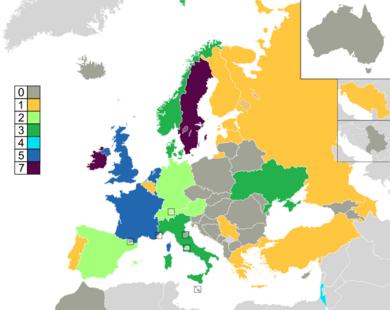
72 songs from 27 countries have won the Eurovision Song Contest as of 2025. Ireland and Sweden have won the most, with seven wins each. France, Luxembourg, the United Kingdom, and the Netherlands have five wins each. Out of 52 countries that have taken part, 24 have not won yet.
Only one contest had multiple winners: in 1969, four songs tied and were all declared winners. This was because there were no tie-break rules then. Most winning songs have been in English, especially since 1999. Since then, only seven winning songs have been fully or partly in another language.
Only one country has won on its first try: Serbia won in 2007. Ukraine won on its second try in 2004. Latvia won on its third try in 2002. Some countries waited a long time for their first win. Greece won in 2005, 31 years after its first try. Finland won in 2006, ending a 45-year wait. Portugal waited the longest, winning in 2017, 53 years after its debut.
Some countries have had long gaps between wins. Switzerland waited 32 years between 1956 and 1988, and another 36 years until 2024. The Netherlands waited 44 years between 1975 and 2019.
The United Kingdom has finished second 16 times, more than any other country. Norway has finished last a record 12 times. It has scored "nul points" (zero points) four times, sharing this record with Austria. Countries have won two years in a row four times. Ireland won three times in a row from 1992 to 1994. They also won in 1996, giving them four wins in five years.
The winning artist, songwriter, and broadcaster receive a trophy. Since 2008, it's a handmade glass microphone. The previous year's winner usually presents the award.
Special Performances and Guests
Besides the songs, there are always performances from non-competing artists. These are a key part of the show. They include music, dance, and circus acts. Past winners often return to perform their winning song.
The opening and interval acts are very memorable. They happen before and after the competing songs. These acts often show off the host country's culture. For example, "4,000 Years of Greek Song" was performed at the 2006 contest. Some acts are funny, like "Love Love Peace Peace" in 2016.
Riverdance first appeared as an interval act at the 1994 contest in Ireland. This seven-minute performance of Irish music and dance became a huge success. It later grew into a full stage show.
Other famous artists who have performed without competing include Aqua (2001), Apocalyptica (2007), and Cirque du Soleil (2009). There have also been guest appearances from actors, athletes, and even astronauts. These guest performances sometimes respond to world events. For example, the 1999 contest ended with a tribute to victims of the Kosovo War. The 2022 contest featured anti-war songs because of the Russian invasion of Ukraine.
Eurovision's Impact
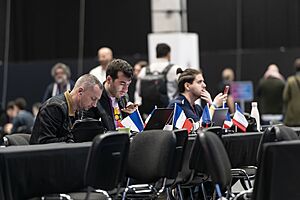
The Eurovision Song Contest has fans all over the world. It gets between 100 and 200 million viewers each year. It has become a big part of global culture. Many people find it fun and unique. It's often parodied in TV shows and comedy festivals.
Several films have been made about the contest. These include the 2020 Netflix musical comedy, Eurovision Song Contest: The Story of Fire Saga.
Eurovision has a large online following. Many websites, news blogs, and fan clubs are dedicated to it. One of the oldest and largest fan clubs is OGAE. It started in 1984 in Finland. It now has branches in over 40 countries. These clubs host events to celebrate Eurovision.
Before each contest, smaller events called "pre-parties" are held. These feature the artists who will compete that year. They perform and meet fans. Eurovision in Concert in Amsterdam was one of the first. Other events include the London Eurovision Party and PrePartyES in Madrid. During the COVID-19 pandemic, many events were held online. EurovisionAgain was an initiative where fans watched past contests together online.
Other Contests and Events
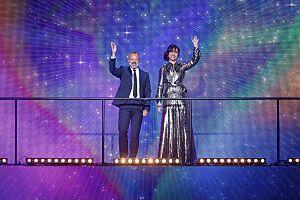
The EBU has organized special anniversary events and related contests. Broadcasters also sometimes make special Eurovision shows for their own viewers. Other similar contests have been created outside the EBU.
The EBU has celebrated Eurovision's anniversaries:
- Songs of Europe in 1981 celebrated 25 years. It featured past winners.
- Congratulations: 50 Years of the Eurovision Song Contest in 2005 celebrated 50 years. It picked the most popular song from the first 50 years.
- Eurovision Song Contest's Greatest Hits in 2015 marked the 60th anniversary. It was a concert with past Eurovision artists.
- After the 2020 contest was canceled, Eurovision: Europe Shine a Light was a special show. It honored the songs and artists that would have competed.
Other contests organized by the EBU include:
- Eurovision Young Musicians: A classical music competition for young European musicians (12-21 years old).
- Eurovision Young Dancers: A dance competition for non-professional dancers (16-21 years old).
- Eurovision Choir: A singing competition for non-professional choirs.
- Junior Eurovision Song Contest: A similar song contest for singers aged 9-14.
- The Eurovision Dance Contest was a dance event held in 2007 and 2008.
Other international music competitions have been created outside the EBU. The Sopot International Song Festival has been held since 1961. The OTI Festival was a contest for Spanish and Portuguese-speaking broadcasters. The Turkvision Song Contest is for countries with Turkic links. An American version, the American Song Contest, was held in 2022. It featured songs representing US states and territories.
See also
 In Spanish: Festival de la Canción de Eurovisión para niños
In Spanish: Festival de la Canción de Eurovisión para niños



